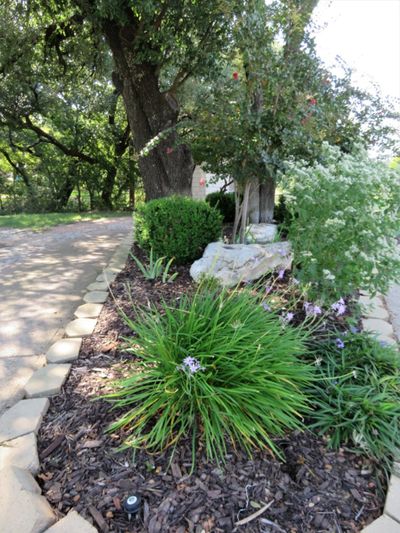Planning Your Xeriscape Design
Here are some things to consider when planning your xeriscape design:
Take notes of problem areas
Take a walk along your property and survey the landscape. Observe and take note of areas that are especially difficult to water and maintain. These areas could include sites such as steep slopes, corners or narrow strips of lawn, rocky areas, and water or drought-prone locations. Steep slopes, especially those on south and west exposures, waste water through runoff and evaporation. Drip irrigation that slowly applies water over longer periods of time may minimize runoff. Another idea is to convert these areas to perennials or ground covers that tolerate the exposure and thrive on little water. They are also easier to maintain.
Manage lawn size
Try to size areas of the lawn accordingly. Irregularly shaped areas should be re-shaped to fit irrigation patterns and converted to drip irrigated xeric plantings or hardscape. High-traffic areas in the yard are best left to turf grasses, such as bluegrass, that can take the wear. Xeric grasses, such as buffalo grass, have less wear tolerance but survive on less water. These types of grasses are best suited for low-traffic areas of the lawn. Other lesser-used areas, however, can be easily transformed into shrub borders, flower gardens, and non-turf ground covers that use less water. Designated paths can be implemented with the use of stepping stones or flagstones, with a dwarf ground cover planted among the stones if desired. Look for lawn areas that do poorly because of heavy shade from trees or structures. Rather than keep these areas in traditional lawn grass, plant shade-tolerant grasses or ground covers that tolerate shade. Alternatively, you could incorporate a patio or deck in these areas as well. Rocky areas of the landscape are easy to fix. These areas can be transformed into beautiful rock garden designs. There are a number of plants that can be successfully grown in rock gardens. As for both water and drought-prone areas of the lawn, consider incorporating your plantings in raised beds. These beds should have an informal planting style with a mixture of drought-resistant shrubs, trees, and flowers. This mixture lessens the competition between individual plants and helps ensure that something in the bed is always looking good. The use of planting beds also makes it possible to incorporate organic matter into the soil before planting, promoting healthier soil and healthier plants.
Choose appropriate plants
The best xeriscape designs include both native and drought-tolerant plants. These should always be grouped together according to their specific watering needs. Plants that are less drought-hardy, for example, need to be confined to another location of the landscape with other relative plants. The idea is to lessen the need for watering, therefore, you only water what needs to be watered. You should also include some method of drip irrigation in your design plan. Soaker hoses are ideal for watering your garden as they tend to allow water to thoroughly soak into the ground rather than running off as is the case for most sprinkler systems. There are many ways you can design your xeriscape garden. You don’t need to feel limited to planting only a few types of plants. Xeriscape gardens can be designed in many styles such as Mediterranean or Southwest gardening styles. Select the style most suitable to your landscape conditions to achieve a greater effect. If you choose plants wisely and practice good xeriscape principles, no matter what kind of design you have chosen, you will have a beautiful, thriving xeriscape garden to be proud of.
